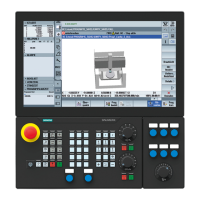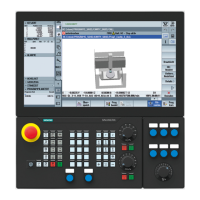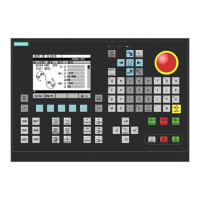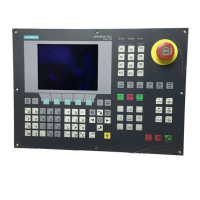Detailed Description
2.4 Frames
Axis Types, Coordinate Systems, Frames (K2)
Function Manual, 08/2005 Edition, 6FC5397-0BP10-0BA0
2-101
It is permissible to specify a single solid angle. The rotations which are performed with ROTS
or AROTS in this case are identical to those for ROT and AROT.
An expansion of the existing functionality arises only in cases where exactly two solid angles
are programmed.
The two programmed axes define a plane, the non-programmed axis defines the related
third axis of a right-hand coordinate system. Which axis is first and which second is then
unambiguously defined for both programmed axes (the definition corresponds to those found
in the plane definition of G17/G18/G19). The angle programmed with the axis letter of an
axis of the plane then specifies the axis, around which the other axis of the plane must be
rotated in order to move this into the line of intersection, which the rotated plane forms with
the plane surrounded by the other and the third axis. This definition ensures that, in the case
that one of the two programmed angles is towards zero, the defined plane enters the plane,
which is created if only one axis is programmed (e.g., with ROT or AROT).
The diagram shows an example where X and Y are programmed. Y here gives the angle, by
which the X axis must rotate around the Y axis to bring the X axis to the line of intersection
formed by the oblique plane and the XZ plane. The same principle applies for the
programmed value of X.
Note
In the shown position of the oblique plane the value of Y is positive, that of X on the other
hand negative.
The specification of the solid angle does not define the orientation of the two-dimensional
coordinate system within the plane (i.e., the angle of rotation around the surface normal
vector). The position of the coordinate system is thus determined so that the rotated first axis
lies in the plane, which is surrounded by the first and third axes of the non-rotated coordinate
system.
This means that
• When programming X and Y the new X-axis lies in the old Z-X plane.
• When programming Z and X the new Z-axis lies in the old Y-Z plane.
• When programming Y and Z the new Y-axis lies in the old X-Y plane.
If the required coordinate system does not correspond to this basic setting, then an
additional rotation must be performed with AROT....
On programming the solid angles, they are converted into the equivalent RPY or Euler
angles, depending on machine data
MD10600 $MN_FRAME_ANGLE_INPUT_MODE.
These then appear also in the display.

